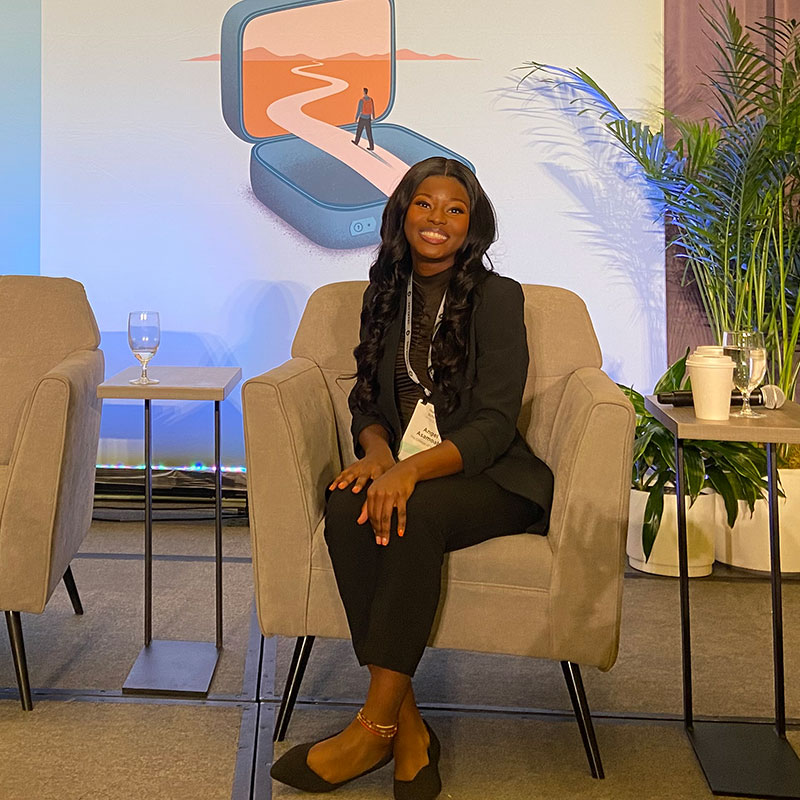The Program in Neuroscience is housed in the Ruth W. Williams Hall of Life Sciences, providing modern, expansive space for classrooms, teaching laboratories, and research laboratories. The Program in Neuroscience shares numerous research labs, classrooms, and offices with the Departments of Biology, Chemistry, and Psychology, and the Interdisciplinary Programs in Biochemistry & Molecular Biology and Environmental Studies.
Research facilities and equipment available to neuroscience majors include advanced microscopy, aquatics, EEG/ERP laboratory, environmental neuroendocrinology laboratory, eye-tracking, human cognitive research facilities, vertebrate animal facilities for birds and rodents, and vertebrate animal facility for fish.
Advanced Microscopy
 Ruth W. Williams Hall currently houses a suite of microscopes for both teaching and research. Four imaging stations are available for teaching purposes. Each station is outfitted with an IX73 Olympus epifluorescent inverted microscope, a digital camera, and laptop computer. A cryostat and vibratome are also available for making thin sections of tissue. Williams Hall also houses a research-grade Olympus Fluoview 3000 scanning laser confocal microscope in a dedicated microscopy room. The confocal is outfitted with multiple excitation lasers and software for deconvolution and image analysis. Additional resources are available (TEM, SEM, laser dissection, and additional confocal imaging) at the nearby Ohio State Agricultural Research and Development Center (OARDC), which is also located in Wooster, Ohio.
Ruth W. Williams Hall currently houses a suite of microscopes for both teaching and research. Four imaging stations are available for teaching purposes. Each station is outfitted with an IX73 Olympus epifluorescent inverted microscope, a digital camera, and laptop computer. A cryostat and vibratome are also available for making thin sections of tissue. Williams Hall also houses a research-grade Olympus Fluoview 3000 scanning laser confocal microscope in a dedicated microscopy room. The confocal is outfitted with multiple excitation lasers and software for deconvolution and image analysis. Additional resources are available (TEM, SEM, laser dissection, and additional confocal imaging) at the nearby Ohio State Agricultural Research and Development Center (OARDC), which is also located in Wooster, Ohio.
Aquatic Facility
Ruth W. Williams Hall has an Aquaneering Zebrafish Housing system which consists of a seven-shelf double-sided rack that allows for a flexible arrangement of tanks from 1.4 to 9.5 liters in size. All tanks are maintained on a self-contained water filtration system that controls water pH, conductivity, and temperature. Water parameters in the aquatic facility can be controlled remotely through mobile monitoring. The aquatic facility can support research in a variety of disciplines, including genomics, developmental biology, animal behavior, and organismal physiology, among others.
EEG/ERP laboratory
 Ruth W. Williams Hall houses the EEG/ERP laboratory which is equipped with two actiCHamp EEG systems from Brain Vision. Separate sound-attenuated, lighting-controlled experiment chambers house each system allowing parallel data collection on each. One EEG system is setup for 32-channel recordings, the other for 64-channel recordings. The laboratory uses both actiCHamp active electrodes and actiCAP slim electrodes enabling the recording of brain waves from participants of all demographics. EEG recordings are pre-processed and analyzed by Brain Vison Analyzer 2.2.1. Experiment software is E-prime 3.0.
Ruth W. Williams Hall houses the EEG/ERP laboratory which is equipped with two actiCHamp EEG systems from Brain Vision. Separate sound-attenuated, lighting-controlled experiment chambers house each system allowing parallel data collection on each. One EEG system is setup for 32-channel recordings, the other for 64-channel recordings. The laboratory uses both actiCHamp active electrodes and actiCAP slim electrodes enabling the recording of brain waves from participants of all demographics. EEG recordings are pre-processed and analyzed by Brain Vison Analyzer 2.2.1. Experiment software is E-prime 3.0.
Eye tracking
The EEG/ERP laboratory in Ruth W. Williams Hall is also equipped with a Tobii Nano Pro eye tracker which captures eye gaze data at 60 Hz and is designed for fixation-based studies. The Tobii Nano Pro is a mobile eye tracker which can be flexibly mounted on laptops and desktop screens. Experiment software is E-prime 3.0 with extension for Tobii Nano Pro.
Environmental neuroendocrinology laboratory
Ruth W. Williams Hall also houses a neurondocrinology laboratory that allows measurement of both circulating and tissue-specific hormones. This laboratory is optimized to run ELISAS to detect steroid hormones such as testosterone, cortisol, and corticosterone, as well as some protein hormones in a variety of mammalian and avian species. Equipment for measurement of circulating levels of steroid binding proteins is also available, as well as a cryostat for creating thin slices of tissue in which hormones may also be detected through techniques such as immunohistochemistry. This laboratory is also equipped for the study of interactions of hormones and behavior in free-living songbirds.
Human Cognitive Research Facilities
Ruth W. Williams Hall and Morgan Hall have multiple rooms available for human cognitive research. These rooms provide a quiet environment for testing human participants with a wide variety of cognitive tasks. The rooms are equipped to support various methods like computerized testing (with LiveCode, Qualtrics, Testable, DirectRT, or E-Prime), paper-and-pencil testing, interviews, group testing, dyad testing, or physiological testing (including among others heat rate, pulse, skin conductance).
Vertebrate Animal Facility for Birds and Rodents
 Ruth W. Williams Hall has a vertebrate animal facility for birds and rodents with a total of 16 separate holding, testing and storage rooms. These include two free flight rooms and one colony room for zebra finches, multiple large flight cages, two rodent colony rooms, three testing rooms with video capture technology and associated computers and software, four additional flexible testing/holding spaces, a separate surgical suite with an Isoflurane anesthesia system, and a cage washroom with an automated Lynx cage washer. The Neuroscience program and Biology department share a full-time animal care technician. For behavioral assays, we have several large tubs that can accommodate Morris water maze and water radial arm maze, in addition to a Barnes maze, open field, elevated plus maze, three Med Associates rodent nose poke chambers, and a pair of Columbus Instruments PACS boxes. The Neuroscience program has a license for Noldus EthoVision 14 to digitize all videos for maze analysis.
Ruth W. Williams Hall has a vertebrate animal facility for birds and rodents with a total of 16 separate holding, testing and storage rooms. These include two free flight rooms and one colony room for zebra finches, multiple large flight cages, two rodent colony rooms, three testing rooms with video capture technology and associated computers and software, four additional flexible testing/holding spaces, a separate surgical suite with an Isoflurane anesthesia system, and a cage washroom with an automated Lynx cage washer. The Neuroscience program and Biology department share a full-time animal care technician. For behavioral assays, we have several large tubs that can accommodate Morris water maze and water radial arm maze, in addition to a Barnes maze, open field, elevated plus maze, three Med Associates rodent nose poke chambers, and a pair of Columbus Instruments PACS boxes. The Neuroscience program has a license for Noldus EthoVision 14 to digitize all videos for maze analysis.












 Ruth W. Williams Hall currently houses a suite of microscopes for both teaching and research. Four imaging stations are available for teaching purposes. Each station is outfitted with an IX73 Olympus epifluorescent inverted microscope, a digital camera, and laptop computer. A cryostat and vibratome are also available for making thin sections of tissue. Williams Hall also houses a research-grade Olympus Fluoview 3000 scanning laser confocal microscope in a dedicated microscopy room. The confocal is outfitted with multiple excitation lasers and software for deconvolution and image analysis. Additional resources are available (TEM, SEM, laser dissection, and additional confocal imaging) at the nearby Ohio State Agricultural Research and Development Center (OARDC), which is also located in Wooster, Ohio.
Ruth W. Williams Hall currently houses a suite of microscopes for both teaching and research. Four imaging stations are available for teaching purposes. Each station is outfitted with an IX73 Olympus epifluorescent inverted microscope, a digital camera, and laptop computer. A cryostat and vibratome are also available for making thin sections of tissue. Williams Hall also houses a research-grade Olympus Fluoview 3000 scanning laser confocal microscope in a dedicated microscopy room. The confocal is outfitted with multiple excitation lasers and software for deconvolution and image analysis. Additional resources are available (TEM, SEM, laser dissection, and additional confocal imaging) at the nearby Ohio State Agricultural Research and Development Center (OARDC), which is also located in Wooster, Ohio. Ruth W. Williams Hall houses the EEG/ERP laboratory which is equipped with two actiCHamp EEG systems from Brain Vision. Separate sound-attenuated, lighting-controlled experiment chambers house each system allowing parallel data collection on each. One EEG system is setup for 32-channel recordings, the other for 64-channel recordings. The laboratory uses both actiCHamp active electrodes and actiCAP slim electrodes enabling the recording of brain waves from participants of all demographics. EEG recordings are pre-processed and analyzed by Brain Vison Analyzer 2.2.1. Experiment software is E-prime 3.0.
Ruth W. Williams Hall houses the EEG/ERP laboratory which is equipped with two actiCHamp EEG systems from Brain Vision. Separate sound-attenuated, lighting-controlled experiment chambers house each system allowing parallel data collection on each. One EEG system is setup for 32-channel recordings, the other for 64-channel recordings. The laboratory uses both actiCHamp active electrodes and actiCAP slim electrodes enabling the recording of brain waves from participants of all demographics. EEG recordings are pre-processed and analyzed by Brain Vison Analyzer 2.2.1. Experiment software is E-prime 3.0. Ruth W. Williams Hall has a vertebrate animal facility for birds and rodents with a total of 16 separate holding, testing and storage rooms. These include two free flight rooms and one colony room for zebra finches, multiple large flight cages, two rodent colony rooms, three testing rooms with video capture technology and associated computers and software, four additional flexible testing/holding spaces, a separate surgical suite with an Isoflurane anesthesia system, and a cage washroom with an automated Lynx cage washer. The Neuroscience program and Biology department share a full-time animal care technician. For behavioral assays, we have several large tubs that can accommodate Morris water maze and water radial arm maze, in addition to a Barnes maze, open field, elevated plus maze, three Med Associates rodent nose poke chambers, and a pair of Columbus Instruments PACS boxes. The Neuroscience program has a license for Noldus EthoVision 14 to digitize all videos for maze analysis.
Ruth W. Williams Hall has a vertebrate animal facility for birds and rodents with a total of 16 separate holding, testing and storage rooms. These include two free flight rooms and one colony room for zebra finches, multiple large flight cages, two rodent colony rooms, three testing rooms with video capture technology and associated computers and software, four additional flexible testing/holding spaces, a separate surgical suite with an Isoflurane anesthesia system, and a cage washroom with an automated Lynx cage washer. The Neuroscience program and Biology department share a full-time animal care technician. For behavioral assays, we have several large tubs that can accommodate Morris water maze and water radial arm maze, in addition to a Barnes maze, open field, elevated plus maze, three Med Associates rodent nose poke chambers, and a pair of Columbus Instruments PACS boxes. The Neuroscience program has a license for Noldus EthoVision 14 to digitize all videos for maze analysis.